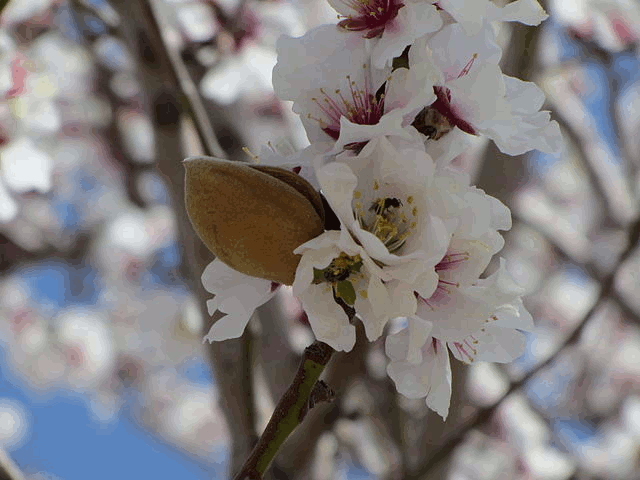Almond
Scientific Name: Prunus dulcis
Climate: Warm and hot
Plant Description: The almond tree is of the Rosaceae family that grows to between three and eight meters in height. It has a gray and cracked trunk. The deciduous leaves have a deep green color. They are pointed, long, eight to 12 centimeters, and narrow, about four cm. It blooms in winter, producing five-petal white or pink flowers. From there the edible fruits and seeds appear, ready to be collected about nine months later. The fruits look like peaches, and produce one or two seeds covered by a hard shell.
Cultivation: The almond tree grows best in warm temperatures. It does not tolerate frosts if they fall in spring because they will affect the harvest. However, it is resistant to cold in winter when the tree is dormant.
It is planted in direct sunlight. It is important that the soil is well drained to avoid root rot. However, it must be irrigated with plenty of water after sowing and then once a week if it is in a region with little rain. If grown from seed, it is best to germinate them before sowing. It is also advisable to apply compost or fertilizers with a high nitrogen content.
The tree must be pruned in winter and dead or diseased branches must be removed throughout the year.
Uses: The almond is very nutritious. It contains vitamins A, B, C and E, fiber, unsaturated fats, phosphorus, calcium and iron. It also provides protein. It is typically used in nougat and marzipan.
Almond oil is used as an emollient and against constipation. It works as an anti-inflammatory and heals cuts. It is applied externally for minor burns, dry skin and acne. It is used for massage as well. It can be used to nourish the wood of musical instruments. Almond milk is used for skincare and as an energy drink.
Almond wood is popular in furniture making and is also used to flavor food on barbecues. Shells can be used in the same way. The leaves can be used in infusions.
Pests and Diseases: The almond tree is affected by a gray fungus called moniliasis that dries and kills the flowers. To avoid this, it is important to fertilize the tree before flowering. If it appears, the affected parts are pruned and a homemade fungicide is applied.
The almond miner is one of the most common pests. It is a worm that attacks the shoots and the larvae eat the fruit inside and the seed. It usually affects young trees. It is essential to prune the affected shoots.
References:
https://www.bioenciclopedia.com/almendro/
https://www.hogarmania.com/jardineria/fichas/arboles/caracteristicas-cultivo-almendro-31795.html
https://www.agroptima.com/es/blog/cultivo-del-almendro/
https://www.cuerpomente.com/guia-plantas/almendro
https://gatule.info/plantas-arboles-frutales/almendro-propiedades-del-arbol/
En español: Almendro

